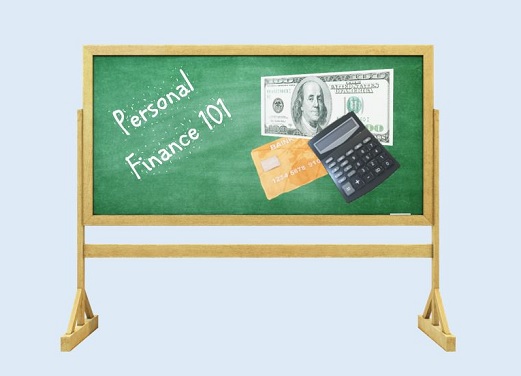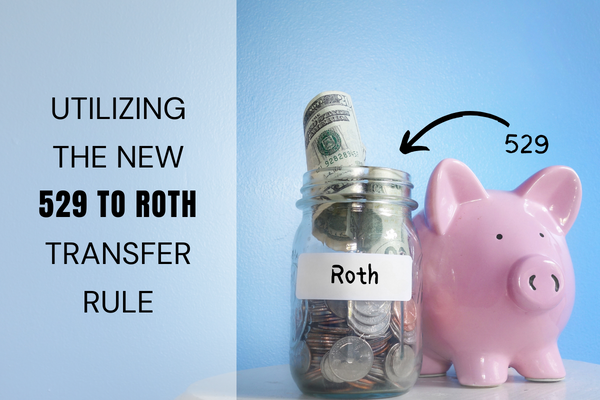Personal Finance 101

“Standing Up For Investors and Helping Them Achieve Investment Success”
January 17, 2019
Market Perspectives – April 2019
April 10, 2019
In preparation for my career as a financial planner, I took classes such as tax, retirement planning, risk & insurance, and trusts & estates. Given my educational background, it would be ludicrous for someone to assume I could surgically remove an appendix upon graduation. At that point, I hadn’t taken a biology class in 7 years. I don’t think I could have identified an appendix, let alone properly removed one. Why, then, do we assume the reverse is normal? Take my sister, for example. She graduated with a degree in exercise and sports science and went on to medical school. She trained to be a doctor, but it’s assumed that, upon graduation, she’ll be able to expertly manage her own finances. Crazy, right?
What’s even crazier is the fact that she was never required to take a single personal finance class during her countless years of education. Knowing that the mitochondria is the powerhouse of a cell isn’t going to help her strategize student loan repayments; being able to deliver a baby isn’t going to help her decide between a Roth vs. traditional 401(k); and honestly, given her schedule so far in med school, it’s looking like she’ll never have time to do anything fun ever again, let alone spend time researching personal finance topics.
If you are in the same boat, this article is for you. It’s just a crash course, but here are a few of the basics to get you started:
Know your credit score
Your credit score is a three-digit number used by banks and other lenders to determine the likelihood that you will repay a loan on time. The most widely used credit scores are FICO® scores. When you apply for a loan, lenders use your score to determine eligibility. A low credit score tells lenders that loaning you money comes with a high level of risk. If a bank considers you a high-risk applicant, they will be less willing to offer you a low interest rate on your mortgage, car loan, or credit card. If your score is very low, they may refuse to offer you a loan at all.
Payment history, total amount owed, credit utilization, and the length of time you’ve had credit are just a few of the factors used in credit score calculations. Making sure your loan payments are made on-time is key in building and maintaining a good credit score.
If you’ve ever had a credit card or put utilities in your name, you probably have a credit score. In fact, you have three credit scores – one from each of the main credit bureaus (Equifax, Experian, & TransUnion). They all use their own credit scoring models. You can find your current credit scores for free on sites like Freecreditscore.com and Creditkarma.com. Be sure you’re on the correct site before providing any personal information.
Create a Budget
Creating a budget is simple. Following a budget? Not so much. Before jumping in and immediately setting restrictions, track your spending for a few months. I use mint.com to help categorize my spending online but paper and pen work just as well. Knowing what you currently spend in various categories will help you determine where you can most easily cut back. After three months, look at what you’ve spent and set a realistic budget based on those numbers. The next month, challenge yourself to spend less in each category. It will always be hard adjusting to lower spending levels but after a few months, it will become your new normal. When you get comfortable, try cutting back even further. Following these steps will help you “find” money that can either be used to pay down debt or save towards other goals.
Start Paying Down Debt
Not all debt is bad debt. It might feel that way when the monthly bill comes due, but some debt, such as student loans and mortgages, can be categorized as “good debt.” A college degree can help generate long-term income and the home, on which the mortgage is extended, can grow in value. Bad debt is typically debt that is taken out to buy things that do not grow in value. Credit card debt, which typically comes with a high interest rate, is an example of bad debt.
Whether you have good or bad debt, you should always pay the monthly required amount at a bare minimum. If your cash flow allows you to pay more, do so. If you have multiple loans, prioritize applying extra payments to the loan with the highest interest rate first. When you pay that off, apply those extra payments to the loan with the 2nd highest interest rate. Chip away at your loans from highest to lowest interest rate until they’re gone. Create a payment plan, stick to the plan, and enjoy your progress. Paying off debt can be a very long (but rewarding) process, so targeting the loan with the highest interest rate can save you the most in interest over that time.
Create an Emergency Fund
You lose your job. Your car breaks down. You are too sick to work for an extended period. How do you pay your rent? How do you afford groceries? How do you fix your car? If you do not have an emergency cash account, you’ll probably use a credit card. To prevent taking on bad debt because of an emergency, open a savings account specifically earmarked for emergencies with cash you can access at any time. In other words, this account should never be invested in the market. If you’re single, you should target cash savings equal to 6-9 months of basic living expenses. If you’re married and both you and your spouse have steady income, you can reduce the goal to 3-6 months.
Although it doesn’t technically matter where you open your savings account, it’s typically easier to maintain at a bank separate from the bank that holds your checking account. Keeping your emergency fund at a separate bank prevents you from tapping it for quick money. If you choose to keep your emergency fund at a separate bank, look for banks that offer high interest savings accounts with no monthly maintenance fees. Some banks are currently offering yields upwards of 2% on savings accounts which can easily beat the interest paid on the average checking account.
Wherever you establish your emergency savings account, be sure to have one and do not, I repeat – DO NOT, tap into it for anything aside from true emergencies.
Save for Retirement
Though retirement can sound like a distant dream, it is extremely important to start saving for retirement as early as you can. As with all savings, there’s this beautiful thing called “compound interest” that acts similarly to the snowball effect. Let’s say you put $1,000 into a retirement account. If you earn 6% on that account in the first year, you end the year with $1,060. The next year, you don’t add any more money to the account, but it again earns 6%. Your account’s value would be $1,123.60 at the end of year two. The 6% growth is applied to both the $1,000 you originally contributed and the $60 of growth you earned in year one. At the end of year 10, assuming a constant 6% annual growth, your account would hold a whopping $1,790.85 even though you only contributed $1,000. Just imagine that same effect on a larger scale. The more time you give your savings to grow, the greater the effect. All this is to say – start early. Let your money work for you.
The most widespread types of retirement accounts are the 401(k) and the IRA (individual retirement account). 401(k)s are only available through your employer while IRAs can be opened at the bank or brokerage firm of your choice – Vanguard, Fidelity, etc. Whether you have a 401(k), an IRA, or both, you are not allowed to contribute more than $22,500 to the 401(k) and $6,500 to the IRA in 2023, assuming you are under 50 years old. Both accounts are restricted until you turn 59 ½ years old. If you take money out of these accounts before you reach 59 ½, a 10% penalty may be applied, in addition to any taxes you may owe.
Both 401(k)s and IRAs can be either “Roth” or “Traditional.” Traditional IRAs and 401(k)s are funded with pre-tax contributions. This means, in general, the IRS will allow you to deduct the contribution amount from your income on your tax return (subject to certain income limits). In other words, the money going into traditional retirement accounts has never been taxed. When you begin taking distributions from your traditional IRA or 401(k) in retirement, the full distribution is taxed as if it were ordinary income. You didn’t pay taxes on the front end, so you must pay taxes on the back end.
Roth IRAs and 401(k)s work in the opposite way – you pay taxes on the front end and don’t pay taxes on the back end. Said differently, contributions to Roth accounts are made with after-tax dollars and distributions from Roth accounts in retirement are received tax-free. Because of these differences, earnings in traditional accounts are said to “grow tax-deferred” while earnings in Roth accounts are said to “grow tax-free.” For young people especially, we strongly recommend contributing to a Roth IRA or Roth 401(k) if it’s available.
We recommend earmarking ~15% of your income towards saving for retirement. If you are just starting out and can’t fathom putting that much away, at a very minimum save up to your employer match, if offered. It is very common for employers to offer to match your 401(k) contribution up to a set percentage. For example, if an employer says they’ll match 100% of your contribution until your contribution reaches 3% of your salary, you should be saving at least that 3% of your salary. If your employer offers a match, saving less than the matched percentage would be turning down free money. Everyone can agree that that’s never a good idea.
Buy the Proper Amount of Insurance
Both life and disability insurance are extremely important to consider early on in one’s career to ensure that catastrophic events, such as death or disability, do not interfere with your current lifestyle or progress towards your goals. Neither is a “get it and forget it” situation. With every life change, levels of coverage should be reexamined.
Life Insurance – Life insurance is a contract that pays out a sum of money at the death of the insured. The two most common types of life insurance policies are term and permanent. Term insurance is typically cheaper and covers the insured for a set number of years. Permanent insurance, the more expensive option, covers the insured for his or her entire lifetime.
How do you know if you need life insurance? If you die tomorrow, would anyone be affected financially? If not, you might not need a great deal of insurance, if any at all. Alternatively, if someone would be financially affected (e.g., your income supports a family, or you own a home) a life insurance needs analysis may be warranted.
While some employers offer group insurance coverage, they usually only remain in force until you leave the company and often fall short in terms of death benefit. To supplement group coverage, most professionals need personal policies. In our experience, buying term insurance, as opposed to permanent, is often the best course of action for most individuals. Not only do term policies offer cheaper premiums, which permits more income to be saved, term policies also allow for more flexibility as your situation changes.
There are a few different rules of thumb when it comes to a recommended level of coverage. We typically encourage our clients to cover their current outstanding liabilities, at a bare minimum.
Disability – A person’s greatest asset is typically their future ability to earn income. Disability insurance protects against the possible loss of income due to illness or injury. Both long-term and short-term disability policies exist. Short-term insurance pays out a percentage of your income for a set number of months, usually between 3 and 6. Long-term insurance policies have longer benefit periods that can range anywhere from a couple of years to the remainder of your working career.
In most cases, we would not recommend purchasing a short-term disability policy due to high cost. Instead, we would advise a client to buy the maximum long-term disability coverage available (usually 60%-70% of your income) and ensure he or she has enough money in an emergency fund to cover expenses during the elimination period, or the time that must pass before benefits kick in, which is typically 3-6 months. If your employer’s coverage does not reach 60-70%, consider buying a small independent policy to fill in the gap. The benefit period need can vary, but most individuals opt for five years of coverage.
A key difference between policies is their definition of “disabled.” Some use “own occupation” and others use “any occupation.” A policy that uses “own” as its definition will pay out if you are not able to do your current job, even though you may be able to work another job. A policy that uses a definition of “any” will not pay out unless you aren’t able to work at all.
Create an Estate Plan
Even if you are young and unmarried, we suggest you create an estate plan. You probably only need a simple set of documents made up of (1) a Durable Power of Attorney, (2) an Advance Medical Directive, and (3) a Will.
- A Durable Power of Attorney gives someone permission to manage your assets on your behalf if you become incapacitated.
- An Advance Medical Directive outlines your medical care preferences if you are unable to make decisions for yourself. Laws governing advance directives vary from state to state, so be sure to use your state’s advance directives. In North Carolina, an advance medical directive includes (a) A Health Care Power of Attorney which gives someone permission to make decisions about your health care in times of your incapacitation and (b) An Advance Directive for a Natural Death (aka, a Living Will) that outlines medical treatments you would and would not want used to prolong your life (e.g., CPR, ventilation, feeding tubes, etc.) as well as other medical preferences surrounding organ donation. HIPAA authorizations, which give your doctor permission to disclose protected health information to the individual of your choice, are frequently being integrated into Living Wills. If the language is not present, an additional form may be necessary.
- A Will allows you to direct where your assets will go when you die.
Once drafted, you should have an attorney review your estate documents every 7-10 years or following any major change in life circumstances. As your situation gets more complex (e.g., marriage, kids, big purchases, etc.), a more complex estate plan may be warranted.
When should I talk to a financial planner?
Losing sleep at night over your financial decisions? Don’t have enough time to properly manage your finances? Can’t stick to your plan and fear it’s having a negative impact on the intended outcome? Want an expert in your corner who knows your situation and can generate ideas? These are just a few of the countless reasons individuals and families decide to partner with financial planners.
If you have decided you are interested in working with a planner, please be sure to do your homework. Due to the lack of regulation in our industry, there are countless individuals out there who are legally allowed to hold themselves out as “financial advisors” but might not have your best interests at heart. If you are wondering what you should consider when hiring a financial advisor, check out Abby Bennett’s article here.
Bridget McDermott, CFP® is a financial planner in Charlotte, NC. Click here to learn more about Bridget.
Carolinas Investment Consulting is not affiliated with any of the websites linked in this commentary. Nothing contained herein constitutes financial, legal, tax, or other advice. The views and opinions expressed in this article are those of the author and do not necessarily reflect the official policy or position of Carolinas Investment Consulting. The information published herein is provided for informational purposes only, and does not constitute an offer, solicitation or recommendation to sell or an offer to buy securities, investment products or investment advisory services. All information, views, opinions and estimates are subject to change or correction without notice. The appropriateness of an investment or strategy will depend on an investor’s circumstances and objectives. These opinions may not fit to your financial status, risk and return preferences. Past performance is not indicative of future returns.



